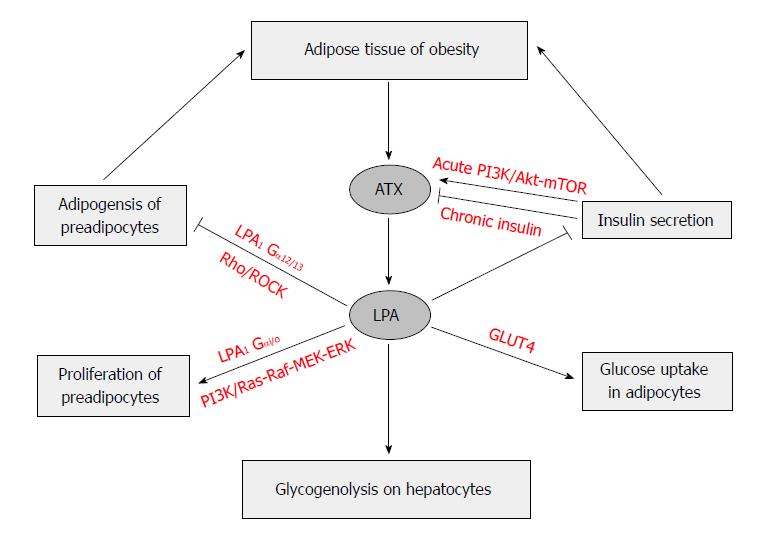Copyright
©The Author(s) 2018.
World J Gastroenterol. Sep 28, 2018; 24(36): 4132-4151
Published online Sep 28, 2018. doi: 10.3748/wjg.v24.i36.4132
Published online Sep 28, 2018. doi: 10.3748/wjg.v24.i36.4132
Figure 4 Autotaxin-lysophosphatidic acid signaling axis regulates adipose tissue development and glucose homeostasis in obesity.
In adipose tissue, especially in mature adipocytes, the elevated expression of AXT leads to production of LPA and then induced proliferation of preadipocytes via LPA1 through Ras-Raf-MEK-ERK pathway. On the other hand, LPA inhibits differentiation of white and brown preadipocytes, which is mediated by LPA1via the Rho-ROCK pathway. Short-term insulin treatment increases ATX secretion in adipocytes via PI3K/Akt-mTOR pathway, whereas long-term insulin treatment reduces ATX activity. LPA produced by ATX in obesity has a tonic inhibitory effect on glucose homeostasis through inhibition of insulin secretion in isolated pancreas islets, increase of glucose transport in myocyte and adipocytes via GLUT4 translocation in a PI3K dependent manner, and elevation of glycogenolysis in hepatocytes. ROCK: Rho-associated kinase; PI3K: Phosphatidylinositol 3-kinase; MEK: Mitogen-activated protein kinase; ERK: Extracellular signal-regulated kinase; Akt: Protein kinase B; mTOR: Mammalian target of rapamycin; GLUT4: Glucose transporter type 4.
- Citation: Yang F, Chen GX. Production of extracellular lysophosphatidic acid in the regulation of adipocyte functions and liver fibrosis. World J Gastroenterol 2018; 24(36): 4132-4151
- URL: https://www.wjgnet.com/1007-9327/full/v24/i36/4132.htm
- DOI: https://dx.doi.org/10.3748/wjg.v24.i36.4132









